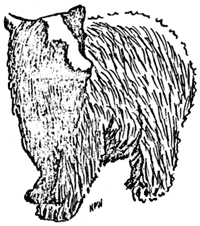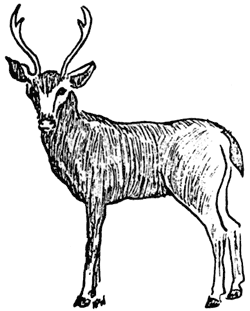|
Volume XII No. 1 - October, 1946
An Ecological Appreciation Of The Lake Trail
By W. J. Nee, Ranger-Naturalist
From the standpoint of botanical appreciation, one of the
outstanding Self Guiding Nature Trails of Crater Lake National Park is
the Crater Wall Trail commonly referred to as the Lake Trail. This
trail has: first, a large number of floral species; second, a broad
range of plant associations due to moisture, temperature and altitude;
and third, the most extreme spread of flowering time.
Approximately 75 species can be readily identified on the Lake
Trail. The following is a partial list of the more prominent plants:
mountain hemlock, white bark pine, sedge, Engleman's aster, Newberry's
knotweed, false helebore, tall ragwort, feather-leaf leutkea, heart-leaf
arnica, Crater Lake currant, smooth wood rush, one-sided pyrola,
Brewer's mitrewort, Tomie's Saxifrage, creeping raspberry, crustaceous
lichen, staghorn lichen, fireweed, mountain sorrell, red elderberry, mat
huckleberry, rock penstemon, long-leaf arnica, bleeding heart,
columbine, fivefinger, western boneset, Jacob's ladder, thorny currant,
parsely fern, alpine everlasting, Hall's currant, western white pine,
Shasta red fir, mitella, willow herb, white veined pyrola, Merten's
corallroot, mat manzanita, Bongard's buttercup, Lewis's monkeyflower,
Gorman's stonecrop, pearly everlasting, pine paintbrush, sulphur flower,
phacelia, hawkweed, kellogia, mountain maple, fat solomon seal, slim
solomon seal, snowberry, prince's pine, baneberry, fleabane, western
wind flower, holly fern, mountain ash, squaw carpet, broom huckleberry,
Douglas phlox, veronica, yellow monkey flower, arabis platysperma, and
Sitka valerian. Many of the earlier blossoming plants, the grasses, and
varieties of sedges are not listed here.
A typical plant association of the upper area is the mountain
hemlock, smooth wood rush, and Crater Lake currant association. An
excellent example of this association can be seen toward the end of the
second switchback. At the end of the seventh switchback is an
association of plants that frequent rocky ledges including parsley fern,
and crustaceous lichens. At the end of the ninth switchback, the
altitude is sufficiently low for the Shasta red fir and western white
pine to mingle with mountain hemlock. As on faces the lake, one looks
right into the tops of each of the above named trees. Limb pattern,
foliage, and cones are very convenient for close comparison. There is a
splendid view of a towering cliff immediately behind this tree
association. Along the tenth switchback is a very beautiful growth of
bleeding heart. A decaying log has provided protection and humus to
enhance the beauty of this cluster of flowers.
The thirteenth switchback is a long one but has an association that
is altogether different from any of the preceding. A ledge of
fragmental material has produced a drier situation upon which
characteristic plants have grown. In this association are mat
manzanita, veried-leaf phacelia, pearly everlasting, pine paintbrush,
sulphur flower, Engleman's aster, Gorman's stonecrop, and others.
Another similar association but on a more rocky situation is to be found
on the sixteenth switchback. Here the predominating plant is Gorman's
stonecrop.
One other association of particular interest is at the bottom of the
trail where the Sitka alder and thorny currant form a dense thicket in
the talus. Observation of the alder will explain the many dense green
thickets around the lower reaches of the crater wall. This grows
principally because the drainage from the wall is constant throughout
the growing season.
Because of the exposure, protection from desiccating winds, and the
supply of moisture, the Lake Trail produces the widest extreme in season
of any area so easily available to the public. From the earliest to the
latest part of the season, flowers can be seen in all stages of
development. In early September, this year, there were Lewis
monkeyflowers just coming into bud and blossom while within a few feet,
the same species had completely gone to seed. Within a radius of twenty
feet, one can see the first blossoms of red elderberry, the green
berries and the ripened red berry. Long after the columbine has
disappeared around the Park Headquarters, they are just coming into
blossom at the foot of the Lake Trail. And so it is with many of the
other plants. On this splendid trail, springtime is determined by
environmental factors, which make a brilliant floral display the whole
season through.
Mammal Populations, 1946
By Dr. R. R. Huestis, Ranger-Naturalist

This note is based upon observations, made in Crater Lake National
Park, upon the most easily observable mammal species. The present
season is distinct in two particulars: The park is open to the heavy
public travel for the first time since 1942. The heavy snowfall of the
1945-46 season has provided an exceptional amount of vegetation
throughout the area.
Olympic black bear are not numerous as compared with pre-war years.
The policy of garbage disposal at a considerable distance from any
habited area has been successful in preventing unhealthy concentration
of these animals. A few complaints have been made by campers of bears
stealing foodstuffs left exposed in a vacated camp but these indignant
people are outnumbered twenty to one by visitors equally indignant
because they haven't seen a bear since they entered the park.
Columbia black-tailed deer appear to be exceptionally numerous. They
are commonly seen by visitors and trails are found to be dotted with
fresh footprints whenever they are visited. Deer are commoner than at
any season in the last then years.
Golden mantled ground squirrels are rather scarce. In 1938 about
150 squirrels, by actual count, inhabited the rim area between the Lodge
and the Crater Wall Trail. This year's population appears to be about
one-fifth of this. Squirrels are very numerous along Highway 230 east,
outside the park.

Townsend chipmunks, never very numerous, appear in expected numbers.
Klamath chipmunks have been rarely observed in the rim area this year.
White-footed mice, which in the rim area sometimes enter the cafeteria
or lodge in considerable numbers, have caused no comment this year and
appear to be below average in number. A few have been taken in snap
traps along Munson Creek.
Yellow-bellied marmots may be seen to some extent along the
highways. None has been observed along the Rim Walk, where one or two
could usually be seen. Conies can be seen in the talus slopes along
Garfield Peak Trails but do not call from the rim slopes to any extent
this year. They appear to be present in less than average number.
Signs of the Mazama gopher showed in a few places along the rim
where the snow melted. The most extensive workings in the rim area were
in a small flat between the highway and the cafeteria. When it is
considered that spring melts commonly expose extensive gopher workings
in cleared spaced everywhere in the park area, the numbers of gophers
this year can be considered below average.
Among the medium sized and small carnivores, pine martens have been
reported to be about as numerous as usual. A weasel carrying a
Microtus and, later, the same individual carrying a small
Citellus, was seen at the Information Building. Coyotes have not
been reported at all and foxes rarely.
|

